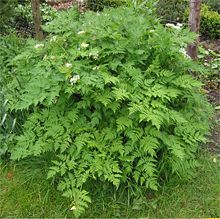- Chervil
-
Garden Chervil 
Scientific classification Kingdom: Plantae (unranked): Angiosperms (unranked): Eudicots (unranked): Asterids Order: Apiales Family: Apiaceae Genus: Anthriscus Species: A. cerefolium Binomial name Anthriscus cerefolium
(L.) Hoffm.Chervil (Anthriscus cerefolium) is a delicate annual herb related to parsley. Sometimes called garden chervil, it is used to season mild-flavoured dishes and is a constituent of the French herb mixture fines herbes.
Contents
Biology
A member of the Apiaceae, chervil is native to the Caucasus but was spread by the Romans through most of Europe, where it is now naturalised.[1]
The plants grow to 40–70 cm (16–28 in), with tripinnate leaves that may be curly. The small white flowers form small umbels, 2.54–5 cm (1.00–2.0 in) across. The fruit is about 1 cm long, oblong-ovoid with a slender, ridged beak.[1]
Root Chervil
Another type of chervil is grown as a root vegetable, sometimes called turnip rooted chervil or tuberous-rooted chervil. This type of chervil produces much thicker roots than types cultivated for their leaves. It was a popular vegetable in the 19th century. Now virtually forgotten in Britain and the United States, root chervil is still used in French cuisine, in soups or stews.
Uses
Culinary arts
Sometimes referred to as "gourmet's parsley", chervil is used to season poultry, seafood, and young vegetables. It is particularly popular in France, where it is added to omelettes, salads and soups. More delicate than parsley, it has a faint taste of liquorice or aniseed.[2]
Horticulture
Chervil is sometimes used to repel slugs.[citation needed]
Traditional
Chervil had various traditional uses. It was claimed to be useful as a digestive aid, for lowering high blood pressure, and, infused with vinegar, for curing hiccups.[3] Besides its digestive properties, it is used as a mild stimulant.[2]
Chervil has also been implicated in "strimmer dermatitis" due to a phytophotodermatitis due to spray from a weed trimmer. Other plants in the family Apiaceae can have similar effects.[citation needed]
Cultivation
Chervil is best grown seeded in place - transplanting can be difficult, due to the long taproot.[3] It prefers a cool and moist location, otherwise it rapidly goes to seed (also known as bolting).[3] Regular harvesting of leaves also helps to prevent bolting.[3] If plants bolt despite precautions, the plant can be periodically re-sown through the growing season, thus producing fresh plants as older plants bolt and go out of production.
Chervil grows to a height of 12 to 24 inches (300 to 610 mm), and a width of 6 to 12 inches (150 to 300 mm).[3]
See also
- Wild Chervil
- Parsnip chervil
- Bur Chervil
- Dill
- Sweet Cicely
References
- ^ a b Vaughan, J.G.; Geissler, C.A. (1997). The New Oxford Book of Food Plants. Oxford University Press.
- ^ a b Gualtiero Simonetti (1990). Stanley Schuler. ed. Simon & Schuster's Guide to Herbs and Spices. Simon & Schuster, Inc. ISBN 0-671-73489-X.
- ^ a b c d e McGee, Rose Marie Nichols; Stuckey, Maggie (2002). The Bountiful Container. Workman Publishing.
Further reading
- Howard, Michael. Traditional Folk Remedies (Century, 1987), p.118.
External links
Edible Apiaceae Ajwain • Alepidea peduncularis • Alexanders • Anise • Anthriscus sylvestris • Apium prostratum • Arracacha • Asafoetida • Bunium persicum • Caraway • Carrot • Celeriac • Celery • Centella asiatica • Chaerophyllum bulbosum • Chervil • Cicely • Coriander • Crithmum • Cryptotaenia • Cumin • Daucus pusillus • Dill • Echinophora sibthorpiana • Erigenia bulbosa • Eryngium foetidum • Fennel • Garden Angelica • Ground-elder • Heracleum persicum • Lomatium • Lomatium parryi • Lovage • Masterwort • Oenanthe javanica • Osmorhiza • Parsley • Parsnip • Perideridia • Radhuni • Ridolfia segetum • Sium sisarum
Categories:- Edible Apiaceae
- Herbs
- Medicinal plants
- Root vegetables
Wikimedia Foundation. 2010.

